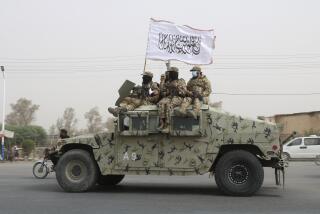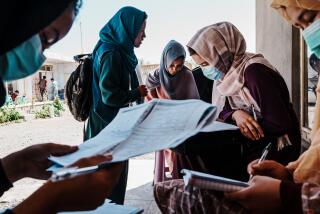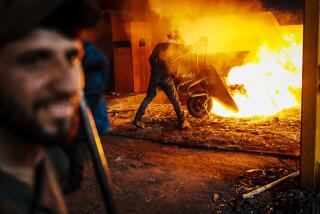Taxi Drivers Offer Ghastly Tour of Kabul
- Share via
KABUL, Afghanistan — Young Muslim guerrillas halt a group of cyclists outside the gutted Russian Embassy in Kabul, hand them shovels and order them to dig a trench.
The guerrillas, members of the Hezb-i-Wahdat faction, brandish assault rifles as the old men finish their task and cycle home.
“No photographs,” shouts a long-haired guerrilla holding two roses and an AK-47 automatic.
The Russian Embassy is one of the sights taxi drivers show visitors in a macabre tour of a city that centuries of travelers have praised for its beauty.
Since the moujahedeen took power from the fallen communist government of President Najibullah in April, 1992, Kabul has been divided into a patchwork of fiefdoms controlled by rival guerrilla parties, often only a few yards apart.
Traffic takes cautiously to the roads during the cease-fires that follow bouts of intense fighting between radical guerrillas and defense ministry forces.
At Kabul Zoo, occupied by guerrillas of General Dostum’s Northern Movement, fighters taunt the monkeys in their cages and use machine guns to prod a wild boar in its rubble-strewn enclosure.
Apart from the tiger, a bear and a few birds of prey, most of the menagerie died long ago, including an elephant donated by the Indian government in 1973.
To the southwest, past bands of tattered fighters who wave down and check all vehicles, stands the shell of the national museum.
Captured by the Iran-backed Shiite Hezb-i-Wahdat from defense ministry troops in mid-May, the upper rooms are burned out and the sheet-metal roof has been torn apart by artillery shells.
The floors are littered with spent ammunition and smashed exhibit cases. Rare books lie torn and scattered around the library.
Looters have taken much of the museum’s collection, which was started by King Amanullah in 1919. It included unique ivory pieces dating from the first and second centuries.
In the overgrown gardens stand charred skeletons of vintage royal limousines, including a Rolls-Royce, pulverized by artillery and rocket fire.
Hezb guerrillas also took the Darulaman Palace on a nearby hilltop, a once impressive French-designed castle that housed the defense ministry.
Kabul’s most historic building, the Fifth-Century citadel of Bala Hissar, is the sandbagged regional headquarters of the Northern Forces.
In Zarnegar Park in central Kabul, a city ringed by snow-capped mountains and ablaze with roses, old men drink tea in the shadow of a gallows.
The scaffold was erected in September when the Islamic government hanged three men in public for offenses including robbery, rape and murder--Afghanistan’s first executions in 20 years.
The International Hotel, noted in one outdated guidebook for its “music, bar and occasional cabaret,” stands empty on a hilltop overlooking the city. The last guest, a German engineer, was driven out in January by power blackouts and rocket attacks.
Down below, the heavily guarded United Nations complex has a guest who cannot leave--Najibullah, who took refuge there 13 months after the moujahedeen entered the city.
More to Read
Sign up for Essential California
The most important California stories and recommendations in your inbox every morning.
You may occasionally receive promotional content from the Los Angeles Times.










